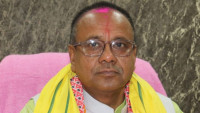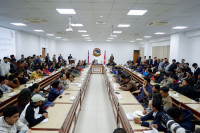National
Lives vs livelihoods? Amid a surge in virus cases, lockdown fears loom
Authorities must devise strategies to contain the spread without imposing blanket restrictions as such curbs can severely impact the economy and the people, analysts say.
Prithvi Man Shrestha
The recent surge in coronavirus cases has left Kashilal Sah worried.
The 49-year-old man from Narakatiya in Rautahat, a district in the Tarai, sells fruits and vegetables on a pushcart in Kathmandu. He has been in the business for the last 34 years, he says.
“But never before did I suffer as much as last year when the country went into a lockdown on March 24,” Sah told the Post earlier this week when he was pushing his cart in the Buddhangar area in Kathmandu. The lockdown led to his confinement in his rented room in Buddhanagar.
With no business, he had no money.
“I survived for days on the food distributed by the local ward office and some kind-hearted people,” he says. “But that did not last long. I decided to return home. I managed to get a lift on a motorbike of an acquaintance up to Narayangarh. From there on, I mostly walked.”
It took him four days to reach home, according to him.
When he returned to Kathmandu after eight months, his landlord exempted the rent for one month.
“I had to pay the rent of seven months,” he says. “Now that the coronavirus cases are rising, I am extremely concerned. Yet another lockdown would be a deadly blow to me.”
After seeing a dramatic decline in the number of new infections, Nepal is now in the grip of a second wave. Cases are rising by the day and hospitals are getting filled with patients. Officials and experts warn that the health facilities would be overwhelmed anytime soon and run out of intensive care unit beds and ventilators.
“People like us who rely on our daily earnings will die if there is another lockdown,” Sah says.
But it’s not just people like Sah, a lockdown would have a devastating impact on all sections of society, according to economists and public health experts. The Nepal government’s last year’s lockdown—from March 24 to July 21—was a spectacular failure. When the country enforced complete restrictions, forcing thousands of people to walk home from Kathmandu to different parts of the country, just two cases had been reported, with one already recovered. When the lockdown was lifted four months later, the number of infections had crossed the 17,000 mark.
On October 21, the country reported the highest daily count of infections at 5,743. Health facilities designated for Covid-19 treatment started to run out of intensive care units and ventilators. Seriously ill patients were dying before reaching hospitals. The government was at its wit’s end and it decided to stop free testing, a decision the Supreme Court eventually overturned, as well as free treatment for the general public. Contact tracing came to a halt, which led to a decline in testing. The number of new cases, however, gradually went down, surprising even experts.
Complacency took hold. On December 20, Prime Minister KP Sharma Oli suddenly dissolved the House of Representatives. Amid political fights, governance took a back seat, and the coronavirus just waited to make a comeback. And now it’s already there.
The number of cases over the past two weeks has steadily climbed.
On Wednesday, the Ministry of Health said the country reported 2,220 new infections in the last 24 hours, a sharp rise from 580 on April 14. With 10 people succumbing to Covid-19-related complications, the death toll has reached 3,112. Kathmandu Valley alone recorded 1,051 new infections in the past 24 hours. Of them, 786 cases were confirmed in Kathmandu, 181 in Lalitpur and 84 in Bhaktapur.
Considering the devastating impact severe measures like lockdowns can have on the economy and people's livelihoods, economic experts suggest that the government must come up with concrete plans to avoid complete and blanket restrictions.
“We should not go for lockdown as long as other measures are available. A nationwide lockdown is a complete no no as cases are spreading in certain pockets only,” said Pushpa Lal Shakya, an expert on macro-economy. “Effective implementation of restrictive measures announced by the government, acceleration of vaccination drive and running awareness campaigns should be tried first.”
According to the Central Bureau of Statistics, the economy is estimated to have shrunk by 1.99 percent in the last fiscal year 2019-20, which is attributed to the lockdown.
In the final quarter of the fiscal year alone, the economy contracted by 15.4 percent. Even after the lockdown was lifted in the third quarter of July last year, prohibitory orders were issued locally, including in the Kathmandu Valley, in the first quarter of the current fiscal year, contributing to contraction of the economy by 4.6 percent.
A study conducted by the National Planning Commission estimated loss of Rs 198 billion to the economy. According to the study, 1.57 million lost their jobs and 1.2 million people were pushed below the poverty line.
The World Bank had estimated in April last year that the pandemic could push nearly one third of the population who are just above the poverty line, below the line due to the loss of livelihoods caused by the pandemic.
“Our consistent view is that lockdown is not a solution and the four-month lockdown last year showed that it destroyed the economy,” said Shekhar Golchha, president of the Federation of Nepalese Chambers of Commerce and Industry. “Selective restrictive measures announced by the government are okay. Let's enforce them effectively. Following health protocols including avoiding gatherings of people and wearing masks and ramping up vaccination drives are the better options.”
According to a Nepal Rastra Bank report released in August last year, 61 percent of the businesses were closed completely during the lockdown while 35 percent were partially open. Only four percent of the businesses were fully open. More macro and small businesses remained closed than the larger ones. When it comes to micro and small enterprises, 61-64 percent of them were fully closed during the lockdown, according to the study.
“We must not consider lockdown as an option at any cost,” said Golchha.
What is concerning is that cases have been rising in neighbouring India, with which Nepal shares a 1,770-kilometre-long open border, at an exponential rate. India is seeing a rise of cases faster in the second wave. In Nepal, doctors have attributed the United Kingdom variant, known as B.1.1.7, to the sudden rise in infections of late.
Hospitals beds now are filling up with the rise in cases.
According to the Health Ministry, there are 1,185 ICU beds and 512 ventilators at government hospitals across the country. A total of 180 Covid-19 patients are currently in ICUs while 47 are on ventilator support.
Doctors say the situation has gone from bad to worse, largely because of the government's poor handling of the pandemic and general public’s careless attitude.
“Of the 60 beds at our hospital, 51 have been already occupied. It is a sharp rise from just two-three cases just about three weeks ago,” said Sagar Kumar Rajbhandari, director at the Sukraraj Tropical and Infectious Disease Hospital, which has been converted into a Covid-19 hospital once again. “If the situation continues to deteriorate, we might be left with no other option than to enforce lockdown.”
The government so far has maintained that it is against imposing a lockdown.
But the measures it has taken to contain the virus too has been far from satisfactory. Earlier this week, it issued a slew of orders–most of them talk about restrictive measures like shutting down schools, not letting restaurants open later than 8pm and banning cinemas, banquet venues, dance bars, dohori places, dancehalls, clubs, health clubs, gyms, swimming pools and futsal courts; assemblies, political rallies, and participation in stadiums.
The service sector was one of the most affected sectors by last year’s lockdown.
According to Araniko Rajbhandari, president of the Restaurant and Bar Association Nepal, the restaurant sector alone lost around Rs1 billion during the four-month lockdown last year, as many workers lost their jobs.
"With the surge in cases, the flow of visitors has already started to slow down," said Rajbhandari. “Particularly, those people who used to visit restaurants with family members have already stopped coming."
According to Rajbhandari, the restaurant sector won't be able to survive yet another lockdown.
"While the government must make efforts to avoid another lockdown, members of the public too should help in containing the virus by following the safety protocols," said Rajbhandari. "Safety protocols must be implemented not only at restaurants but also at other public places."
Just as the virus is spreading, the government is struggling to acquire vaccines.
So far, around 1.9 million people have been vaccinated against Covid-19. The 438,000 people who took the jab in the first phase between January 27 and March 7 are currently taking their booster shots from different hospitals in Kathmandu. Nepal hopes to receive one million of the two million doses of Covishield for which it has paid the Serum Institute of India, in about two weeks. More doses are expected to arrive soon under the World Health Organisation-backed COVAX facility, officials say.
Sameer Mani Dixit, a PhD on molecular biology who has been closely following the coronavirus pandemic in Nepal and across the world, says the measures that the government has announced are timely, but implementation is the key.
“If the restrictive measures that have been announced are implemented in a strict way, it could help slow down the spread of the virus,” Dixit told the Post. “There should not be a lockdown as long as there are beds, ventilators and other medical services. The authorities had ample time to improve hospital infrastructure and add beds and ventiltors before the second wave hit the country.”
According to Dixit, the government should have worked on increasing the number of ICU beds and ventilators and expedited efforts to procure vaccines from other countries.
So far, Nepal’s drug regulator has granted emergency use authorisation to Covishield, the Oxford-AstraZeneca vaccine which is locally manufactured by the Serum Institute of India, BBIBP-CorV produced by China’s Sinopharm, Bharat Biotech’s COVAXIN and Russia’s Sputnik V.
Apart from Covishield, Nepal has used the Sinopharm vaccine to inculcate the population. China had provided 800,000 doses of Sinpharm vaccine under grant assistance. However, only 100,000 people have been vaccinated with Sinopharm.
Jagadish Chandra Pokharel, a former vice-chairperson of the National Planning Commission, says the pandemic has exposed the governance flaw that has plagued the country’s other sectors.
“Just like in other cases, we have not seen decentralisation of pandemic control efforts,” said Pokharel. “Instead of imposing a nationwide lockdown, it is better for the federal government to authorise District Covid-19 Crisis Management Centres and local governments to take appropriate measures to contain the virus.”
Some districts like Banke and Baglung which have reported a massive surge in cases have announced their own restrictive measures so as to control the spread of the virus.
The District Covid-19 Crisis Management Committee headed by chief district officer of Banke on Wednesday announced prohibitory orders, asking closure of everything except highways and airports for a week starting Thursday.
Sah, the vegetable and fruit vendor in Kathmandu, wonders what if the government fails to pay heed to experts’ advice and goes for a blanket lockdown.
“It’s the poor people like us,” said Sah, “who will be affected the most if there is another lockdown.”




 17.12°C Kathmandu
17.12°C Kathmandu















